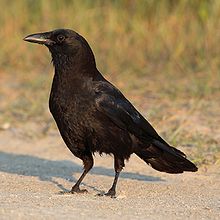
Back زاغ أمريكي Arabic زاغ امريكى ARZ Corvus brachyrhynchos AST Ahasiw ATJ Американска врана Bulgarian Cornella nord-americana Catalan Corvus brachyrhynchos CEB ᎪᎦ CHR Vrána americká Czech Brân America Welsh
| American crow | |
|---|---|

| |
| In Bruce Peninsula National Park, Ontario | |
| Scientific classification | |
| Domain: | Eukaryota |
| Kingdom: | Animalia |
| Phylum: | Chordata |
| Class: | Aves |
| Order: | Passeriformes |
| Family: | Corvidae |
| Genus: | Corvus |
| Species: | C. brachyrhynchos
|
| Binomial name | |
| Corvus brachyrhynchos Brehm, 1822
| |

| |
| Global range | |

The American crow (Corvus brachyrhynchos) is a large passerine bird species of the family Corvidae. It is a common bird found throughout much of North America. American crows are the New World counterpart to the carrion crow and the hooded crow of Eurasia; they all occupy the same ecological niche. Although the American crow and the hooded crow are very similar in size, structure and behavior, their calls and visual appearance are different.
From beak to tail, an American crow measures 40–50 cm (16–20 in), almost half of which is tail. Its wingspan is 85–100 cm (33–39 in). Mass varies from about 300 to 600 g (11 to 21 oz), with males tending to be larger than females. Plumage is all black, with iridescent feathers. It looks much like other all-black corvids. They are very intelligent, and adaptable to human environments. The most usual call is CaaW!-CaaW!-CaaW! They can be distinguished from the common raven (C. corax) because American crows are smaller and the beak is slightly less pronounced; from the fish crow (C. ossifragus) because American crows do not hunch and fluff their throat feathers when they call; and from the carrion crow (C. corone) by size, as the carrion crow is larger and of a stockier build.
American crows are common, widespread, and susceptible to the West Nile virus, making them useful as a bioindicator to track the virus's spread. Direct transmission of the virus from crows to humans is impossible.
- ^ BirdLife International (2018). "Corvus brachyrhynchos". IUCN Red List of Threatened Species. 2018: e.T22705990A131945410. doi:10.2305/IUCN.UK.2018-2.RLTS.T22705990A131945410.en. Retrieved 19 November 2021.
- ^ "Corvus brachyrhynchos". NatureServe Explorer. Retrieved 18 July 2024.

